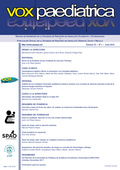![]()
Evolución de la enfermedad neonatal por Streptococcus agalactiae (GBS) y su prevención en el área hospitalaria de Valme de Sevilla en tres periodos
Antecedentes: El Streptococcus agalactiae o estreptococo grupo B (EGB), es uno de los principales microorganismos productores de sepsis y meningitis neonatal. En 1996 el CDC (Centers for Disease Control and Prevention) recomendó el “screening” de S. agalactiae en muestras vagino-rectales de las embarazadas y la administración de profilaxis antibiótica intraparto (PAI) a todas las colonizadas.
Objetivos: Conocer la incidencia y las formas clínicas de la infección neonatal por EGB en tres periodos: Periodo “pre-screening” (1994-1995), Periodo “post-screening” (1999- 2000) y un tercer periodo (2009-2013) con digitalización de la historía clinica e instauración de un nuevo sistema informático en el laboratorio de Microbiología (SIL) (Periodo informático mejorado). También se analizó el impacto de la PAI y de las nuevas técnicas de información en la evolución y prevención de la infección.
Métodos: El sistema de hemocultivos utilizado fue el BACTEC 9240 con los frascos BACTEC PEDIATRIC/F (Becton Dickinson Laboratory). La identificación se realizó con el sistema Vitek2 (bioMerieux). El “screening” de EGB se realizó en muestras vagino-rectales tomadas a las embarazadas entre las 35-37 semanas y sembradas en caldo Todd-Hewitt y posteriormente en medio Granada.
Resultados: La incidencia de la infección neonatal total por EGB en el periodo “pre-screening” (1994-1995) fue 3,07 por 1000 recién nacidos (RN) vivos, mientras que el “post-screening” (1999-2000) la incidencia fue 1,58 por 1000 RN. Con la introducción de los nuevos sistemas de información y digitalización de la historia clínica (2009-2013) la incidencia disminuyó hasta 0,36 por 1000 RN.
Conclusiones: La incidencia de infección neonatal por EGB ha descendido drásticamente tras la implantación del nuevo sistema informático y por las medidas de profilaxis adoptadas.
Abstract: Background: Group B streptococci (GBS) has been among the most common causes of neonatal sepsis and meningitis. In1996 the CDC (Centers for Disease Control and Prevention) recommended to study all pregnant women to determine whether they were colonised by GBS, and to administer intrapartum antibiotic prophylaxis (IAP) to all colonised women.
Objetives: To study the characteristics and evolution of group B Streptococcus (GBS) neonatal diseases in three periods: In the period of preprevention era (1994-1995), in the period of IAP use (1999-2000) and in the period with a new informatic system in the Microbiology laboratory (SIL) (2009-2013), and analyze the impact of prophylactic measures for the prevention of neonatal infections.
Methods: Blood cultures were processed in the BACTEC 9240 system (Becton Dickinson Laboratory) by using the BACTEC PEDIATRIC/F bottle. The identification were performed using the Vitek2 GP card (bioMerieux). A vaginal-rectal swab was obtained in all pregnant women at 35-37 weeks gestation for GBS culture in Tood-Hewitt broth and Granada Agar.
Results: The incidence of neonatal GBS disease has fallen from 3,07 per 1000 live births in the period of preprevention era (1994-1995) to 1,58 per 1000 live biths in the period of IAP use (1999-2000) and to 0,36 per 1000 live biths in the period (2009-2013) with the introduction the a new informatic system.
Conclusions: There has been a significant reduction in neonatal GBS infection due to the new SIL and following the widespread application of IAP.
| Adjunto | Tamaño |
|---|---|
| vox-paediatrica-1-2016-version-web-19-23.pdf | 1.6 MB |



